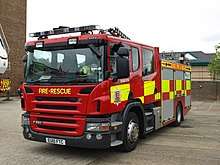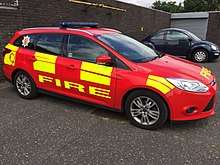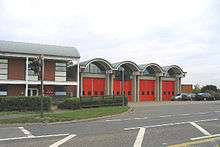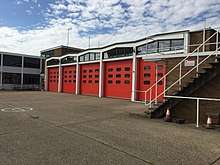Essex County Fire and Rescue Service
Essex County Fire and Rescue Service (ECFRS) is the statutory fire and rescue service for the county of Essex in the east of England, and is one of the largest fire services in the country, covering an area of 1,338 square miles and a population of over 1.7 million people.[1]
 | |
| Operational area | |
|---|---|
| Country | England |
| County | Essex |
| Address | Kelvedon Park, Witham |
| Agency overview | |
| Established | 1 April 1948 |
| Annual calls | ~14,000 incidents |
| Employees | 1,448 |
| Annual budget | £70.1 million |
| Facilities and equipment | |
| Stations | 50 |
| Website | |
| Official website | |
In 2015, the service attended around 14,000 emergency incidents within the year, mostly fires and road traffic collisions (RTC). Additionally, lift releases, effecting entry into buildings, flooding incidents and animal rescues are also incidents dealt with by ECFRS. However, around 40 percent of these incidents are false alarms and require no further action. Between 2004 and 2014 the number of incidents attended by ECFRS decreased significantly by around 50 percent, with around 38 calls per day, compared to around 77 calls per day in 2004.[2]
ECFRS employs 1,448 staff: 620 full-time firefighters, 519 retained firefighters, 33 control personnel and 240 support staff.[3]
There are 50 fire stations in Essex, 12 of which are crewed by wholetime firefighters, or by wholetime and retained firefighters, and are generally located in the more densely populated areas. The remaining 38 stations are staffed by retained firefighters, and tend to be found in smaller towns and villages. Essex used to operate 4 day-crewed fire stations, located at Dovercourt (Harwich), South Woodham Ferrers, Great Baddow and Waltham Abbey, but, following a 2016 consultation [4], these have been changed to retained-only status. ECFRS has 74 frontline fire appliances, with between 55 and 70 available for mobilisation at any moment.[2]
Major risks covered include Stansted and Southend airport, Harwich seaport, Lakeside shopping centre, Coryton oil refinery, power stations and docks at Tilbury and part of the M25 and M11 motorways, A127 and A12 road.
As well as attending fires, traffic collisions and other rescue operations, ECFRS provides emergency response to hazardous materials incidents and has an Urban Search and Rescue (USAR) team of officers with specialist training and equipment to conduct rescues from collapsed buildings and enclosed spaces. The Urban Search and Rescue (USAR) team have their own fire station separate from others across the county, ECFRS being the first to do this in the country. One of their resources include a search dog trained to locate people trapped in rubble. Another primary role of the service is preventive community safety work; in 2010 ECFRS fitted over 7,000 smoke alarms in houses across the county.[1]
Organisation
ECFRS's headquarters is located in Kelvedon. The Service is divided into four Groups:[5]
- North East Group
- North West Group
- South East Group
- South West Group
The Chief Fire Officer/Chief Executive is Jo Turton.
On 1 October 2017, governance of ECFRS was transferred from the Essex Fire Authority (EFA) to the Police, Fire and Crime Commissioner (PFCC), Roger Hirst. It was made very clear, that both Essex Police and ECFRS would retain their Chief Officers, however the new PFCC would have overlying governance over the two, and the Chief Officers would answer to the PFCC. Essex were the first to do this in the country.[6]
The Emergency Operational Fire Control is situated in the headquarters at Kelvedon. 33 control staff handle over 14,000 999 emergency calls. The control staff also carry out incident co-ordination, appliance mobilisation and movements to ensure strategic fire cover. Radio communications are made between incidents and Fire Control, and control staff liaise with other emergency services to provide additional resources when requested by firefighting personnel. Emergency calls are handled on an average of 54 seconds from the time of answering the call, to the time of dispatching the fire crew(s).
There are five firefighter training centres, located in Basildon, Chelmsford, Orsett, Witham and Wethersfield. Each of these centres specialise in different forms of training firefighters must become accustomed to, in order to be operationally prepared.[5]
The Service workshop is in Lexden, Colchester, where the operational fleet of frontline fire appliances and specialist appliances are maintained, and the reserve fleet of spare appliances are stored.
In 2016, the Service started a co-responding scheme with the East of England Ambulance Service, whereby fire crews would respond to life-threatening cardiac emergencies, alongside ambulances, in a way to ease pressure off the ambulance service, and grant better survival for patients. Fire Stations that partook in the scheme were: Basildon, Frinton, Ongar, Newport, Coggeshall and Colchester. However, in 2017, the co-responding scheme ceased due to disputes between the union and the Service. Regardless, the Service still have close relations with the ambulance service, and on a daily basis, fire crews work with partners like paramedics and police officers efficiently.[7]
Appliances


ECFRS has the following fire appliances in operation:
- 43 Rescue Pumps (RP): The standard firefighting appliance mobilised to all rescue calls and reports of building fires. These appliances are equipped with a high-pressure two-stage main pump also capable of making foam via an onboard foam inductor system. They have two high-pressure hose reels, a 13.5 metre ladder, a light portable pump (LPP), six breathing apparatus sets, two spare breathing air cylinders, hydraulic rescue equipment, thermal imaging cameras plus many other tools. These appliances ride with a Watch Manager in charge, along with another 3 - 5 firefighters onboard.[8]
- 20 Water Tenders (WrT): Very similar to the Rescue Pump but with slightly less emphasis on rescue equipment and a greater water capacity. These appliances will have a smaller 10.5 metre ladder but similar general equipment to the Rescue Pump. The Water Tender is mobilised to support the Rescue Pump, or it will respond to incidents that require only one pump, such as grass, chimney or car fires. These appliances ride with a Crew Manager in charge, along with another 3 - 5 firefighters onboard.[8]
- 8 Heavy Rescue Pumps (HRP): Similar to the standard Rescue Pump but specialised more towards heavy rescue operations and incidents (e.g. road traffic collisions). These appliances ride with a Watch Manager in charge, along with another 3 - 5 Firefighters onboard.[8]
- 4 Aerial Ladder Platforms (ALP): A 32 metre extendable ladder platform with a rescue cage, stretchers and additional lighting, these vehicles provide high-level access and firefighting capability, with a vertical reach of almost 32 metres, almost 25 metres laterally, and up to 15 metres below ground level. They are based at Chelmsford, Colchester, Grays and Southend-on-Sea.[1][8]
- 3 Foam Tenders (FT): Introduced in 2011, these units are cheaper to maintain and easier to use than the previous foam vehicles, and can provide state-of-the-art foam proportioning equipment for transport incidents and refinery fires. They are based at Maldon, Orsett and Stansted Mountfitchet.[1][8]
- 2 Incident Command Units (ICU): These vehicles provide a mobile command point at large or protracted incidents whereby fire officers, and officials from many other agencies, can discuss and plan the incident. These are based at Basildon and Clacton.[8]
- 2 Water Bowsers (WB): An appliance equipped with a large 12,500 litre water tank, where pumps can draw water from the Bowser. They are typically used when water hydrant pressure is low, or the area lacks a water supply, such as countryside vegetation fires. These appliances are based at Corringham and Halstead.[8]
- 1 Animal Rescue Unit (ARU): Introduced in 2011, the ARU is based on an all-terrain Unimog chassis and is fitted with a Hiab crane capable of extending up to 13.7 m and lifting weights of up to 3,250 kg. The vehicle is also equipped with three 'pods' containing all the equipment that crews might need to carry out specialist animal rescues; its crew is specially trained in large animal rescue and welfare. It is based at South Woodham Ferrers.[9]
- 1 Hose Layer Unit (HLU): based at Rayleigh Weir.
- 2 Hazardous Material Units (HAZMAT): These are based at Braintree and Rayleigh Weir Fire Station.
- 4 Water Rescue Units (WrU)
- 1 Specialist Operations Vehicle (SOV)
- 4 Off-Road Vehicles (ORV)
- 1 Welfare Module (WM)
- 1 Environmental Module (EM): To help crews contain pollutants at incidents, this unit carries a wide range of equipment including pumps, oil and chemical absorbent materials, booms, drain-blockers and over-drums for containing leaking chemical containers. It was launched in 2011.[10]
- 1 Incident Response Unit (IRU): This appliance is a mass decontamination vehicle, and is based at Chelmsford.
USAR appliances, based at Lexden, include:
- 1 High Volume Pump (HVP)
- 5 Prime Movers with various demountable pods
- 1 Search Dog Unit
- 1 Personnel Carrier
- 1 Line Rescue Vehicle
- 1 Detection, Identification and Monitoring (DIM) vehicle
The Service's driving school is at Chelmsford, and is home to three Emergency Fire Appliance Driving (EFAD) pumps and two multi-purpose driver training lorries.
Training centres at Wethersfield and Witham each have at least two designated training pumps.
As of 2015, the Service announced they would be purchasing brand new fire appliances to replace existing appliances in Essex. Under a money-saving purchasing agreement with Bedfordshire Fire and Rescue Service, 44 new Angloco Scania appliances are being rolled out to fire stations across Essex over the span of 4 years. They will replace: Heavy Rescue Pumps (HRP), Rescue Pumps (RP) and Water Tenders (WrT).[11]
Roles
- Firefighter (FF): carries out day-to-day firefighting work and community safety.
- Crew Manager (CM): in charge of the crew on a fire appliance. Carries out day-today firefighting work and community safety. Can take charge of an incident of up to 2 pumping appliances.
- Watch Manager (WM): in charge of the watch of a fire station. Carries out day-today firefighting work, community safety and other specialist duties. Can take charge of an incident of up to 4 pumping appliances.
- Station Manager (SM): responsible for management at a fire station(s). Carries out day-to-day firefighting work in a specific ground. Can take charge of an incident of up to 8 pumping appliances.
- Group Manager (GM): responsible for management of all fire stations within a specific division. Carries out day-to-day firefighting work in a specific ground. Can take charge of an incident of 9 pumping appliances and above.
- Area Manager (AM): responsible for day-to-day management of a geographical area, operations or policy.
- Assistant Brigade Manager (ABM): responsible for managing various departments and services. Will answer and advice to the Deputy Brigade Manager and Brigade Manager. Will attend the strategic meeting for a large incident.
- Deputy Brigade Manager (DBM): responsible for overseeing various departments and services. Will answer and advice to the Brigade Manager. Will attend the strategic meeting for a large incident.
- Brigade Manager (BM): the principle officer of the service. Responsible for overseeing and managing the overall organisation. Will attend the strategic meeting for a large incident.
In 2016, it was announced that the service will change its rank based structure, to a role based structure, commonly known as 'rank to role'. This process was part of the Peoples Structures Project in the 2016-2020 Essex County Fire and Rescue Service report. This new role based structure is highly popular among many fire services in the country, and suits the modern and flexible requirement of a fire service. This process did not hugely effect the staff and their roles, however did require changes to some Sub Officer's (Watch Manager's) based station of work, in order for the process to be implemented. The service was one of the last organisations to implement 'rank to role'.[12]
Performance
In 2010, the service responded to the scene within an average of 8 minutes 56 seconds (10 minute target), and 93% within 15 minutes (90% target).[13]
In 2014, the service responded to the scene within an average of 9 minutes 10 seconds (10 minute target), and 91% within 15 minutes (90% target).[13]
When the control operator receives an emergency call, the average time it took to identify the emergency and allocate the right resources was between 70–80 seconds. For wholetime crews, a turnout took on average 2 minutes to be ready for mobilisation. For on-call crews, a turnout took on average 4 minutes 30 seconds to be ready for mobilisation.[13]
Fire Stations


This is a complete list of the service's 50 fire stations, both wholetime and retained, the appliances allocated to them, and number of emergency callouts received in 2019:[14][15]
| Station | Number | Duty system | Appliances | Callouts in 2019 |
|---|---|---|---|---|
| Basildon | W52 | Wholetime | RP, WrT, ICU | 1,252 |
| Billericay | W68 | Retained | RP, L6P | 178 |
| Braintree | W78 | Retained | RP, WrT, HazMat | 434 |
| Brentwood | W51 | Wholetime/Retained | HRP, WrT | 591 |
| Brightlingsea | E20 | Retained | RP | 45 |
| Burnham | E43 | Retained | RP, L6P | 121 |
| Canvey Island | W54 | Retained | RP, WrT | 252 |
| Chelmsford | E34 | Wholetime | HRP, WrT, ALP, IRU | 1,169 |
| Clacton | E12 | Wholetime/Retained | RP, WrT, ICU | 798 |
| Coggeshall | E24 | Retained | RP, FRV | 75 |
| Colchester | E10 | Wholetime | HRP, WrT, ALP | 1,185 |
| Corringham | W66 | Retained | RP, WB | 79 |
| Dovercourt | E11 | Retained | RP, WrT, WRU, IRBt | 215 |
| Dunmow | W87 | Retained | RP, WrT | 180 |
| Epping | W89 | Retained | RP, DIM | 193 |
| Frinton | E18 | Retained | RP | 153 |
| Grays | W50 | Wholetime | HRP, WrT, ALP | 953 |
| Great Baddow | E33 | Retained | RP | 105 |
| Halstead | W81 | Retained | RP, WrT, WB | 139 |
| Harlow Central | W70 | Wholetime | RP, WrT, SARV | 1,260 |
| Hawkwell | E47 | Retained | RP | 138 |
| Ingatestone | W67 | Retained | RP, FRV | 35 |
| Leaden Roding | W88 | Retained | RP | 70 |
| Leigh | E31 | Wholetime | RP, WRU, IRBt | 497 |
| Loughton | W72 | Wholetime | HRP | 470 |
| Maldon | E46 | Retained | RP, WrT, WRU, IRBt, FT | 194 |
| Manningtree | E17 | Retained | RP, L6P | 79 |
| Newport | W84 | Retained | HRP, FRV | 67 |
| Old Harlow | W82 | Retained | RP | 68 |
| Ongar | W71 | Retained | RP | 78 |
| Orsett | W55 | Wholetime | RP, WRU, IRBt, FT | 707 |
| Rayleigh Weir | E35 | Wholetime | HRP, HazMat, HL | 536 |
| Rochford | E49 | Retained | RP | 108 |
| Saffron Walden | W85 | Retained | RP, WrT | 184 |
| Shoeburyness | E42 | Retained | RP | 152 |
| Sible Hedingham | W80 | Retained | RP | 64 |
| South Woodham Ferrers | E32 | Retained | RP, ARU, | 99 |
| Southend | E30 | Wholetime | RP, WrT, ALP | 1,229 |
| Stansted | W83 | Retained | RP, L6P, FT | 186 |
| Thaxted | W86 | Retained | RP | 28 |
| Tillingham | E44 | Retained | RP | 29 |
| Tiptree | E23 | Retained | RP | 124 |
| Tollesbury | E45 | Retained | RP | 26 |
| Waltham Abbey | W73 | Retained | RP | 248 |
| Weeley | E19 | Retained | RP | 42 |
| West Mersea | E22 | Retained | RP, WRU, IRBt | 42 |
| Wethersfield | W79 | Retained | RP | 38 |
| Wickford | W69 | Retained | RP | 141 |
| Witham | W25 | Retained | RP, WrT | 202 |
| Wivenhoe | E21 | Retained | RP | 46 |
Southend Fire Station is also home to the UK's first dedicated Young Firefighters' (now Fire Cadets) Centre, opened in July 2010.[16]
Urban Search and Rescue Team (USAR)
State-of-the-art equipment, multi-purpose vehicles, a search and rescue dog and a purpose-built base staffed with a highly trained and experienced team comprise the county's urban search and rescue (USAR) team.
The team is equipped to rescue victims trapped in the rubble of collapsed buildings, or major transport accidents, for example. They are able to locate and safely extract trapped person, and can shore up unstable buildings so that firefighters can continue with rescue operations.
The USAR team are equipped with prime movers, specialist hook-lift vehicles that can be loaded with one of five different equipment pods, depending on what situation the team are going to face. These pods include hose layers and high-volume pumps, technical rescue, timber for shoring up unstable structures, and even a multi-purpose skid loader that can access tight spaces, explore voids, and move heavy loads of debris.
Following the September 11 attacks new risks were identified for which rescue services would need to be better prepared, and the British government responded with the announcement that USAR units were to be established throughout the country. The Lexden base became the UK's first such facility.
ECFRS was chosen as one of the 17 strategically suitable services partly because it already had 14 officers trained in urban rescue, members of the UK Fire Service Safety & Rescue Team who were part of the rescue effort that was sent to Bam in Iran after it was hit by a major earthquake in December 2003 where they helped in the search for victims amongst the ruins of the ancient city.
The station commander at Lexden, a specialist co-ordinator of search and rescue operations, was also sent with the EU Civil Protection Mechanism to Haiti in January 2010 after a major earthquake struck the country.
In February 2011, six ECFRS firefighters, including two from the USAR unit at Lexden, joined the UK's International Search and Rescue (ISAR) team sent to assist with rescue efforts in New Zealand's second city Christchurch after an earthquake hit the region.[17]
In April 2015, six firefighters and rescue dog have been deployed to Nepal to join a team of 67 search and rescue and medical experts to help and look for earthquake survivors.[18]
Formed in 1992, the UK's ISAR team comprises specialist search and rescue officers drawn from 13 brigades who are on call 24 hours a day. The ECFRS team's primary role is urban search and rescue but it has also trained and involved in water rescue and working at height.
Cross-county assistance
ECFRS assisted in the emergency response to floods in Oxfordshire in 2007, where seven firefighters from the Swift Water Rescue team helped rescue victims trapped by the floods with a specialist fireboat.
Essex was also one of 16 brigades called in to attend the Buncefield oil depot fire near Hemel Hempstead, Hertfordshire, in December 2005. Fire appliances from Orsett, Hadleigh, Harlow, and foam appliances from Grays, Maldon and Epping assisted in operations at the largest ever blaze in peacetime Britain.
See also
- Fire services in the United Kingdom
- Orsett Hall fire
- List of British firefighters killed in the line of duty
Other emergency services:
- Essex Air Ambulance
- East of England Ambulance Service
- Essex Police
References
- http://www.essex-fire.gov.uk/_img/pics/pdf_1441197562.pdf
- http://www.essex-fire.gov.uk/_img/pics/pdf_1487254707.pdf
- http://www.essex-fire.gov.uk/_img/pics_1551199332.pdf
- "Essex County Fire & Rescue Service: About us, (accessed 16 Jan 07)". Archived from the original on 18 July 2011. Retrieved 1 August 2010.
- http://www.essex-fire.gov.uk/EPFCC_FR_Authority/
- http://www.essex-fire.gov.uk/news/Fire_appliances_responding_to_cardiac_arrests/
- https://www.whatdotheyknow.com/request/347449/response/848552/attach/3/FOIA%203003%2016%20vehicle%20list.pdf
- "Archived copy". Archived from the original on 28 September 2011. Retrieved 15 May 2011.CS1 maint: archived copy as title (link)
- "Archived copy". Archived from the original on 28 September 2011. Retrieved 20 July 2011.CS1 maint: archived copy as title (link)
- http://www.essex-fire.gov.uk/news/New_fire_appliances_for_Essex/
- http://www.essex-fire.gov.uk/_img/pics/pdf_1488196029.pdf
- http://www.essex-fire.gov.uk/_img/pics/pdf_1482341003.pdf
- "Archived copy". Archived from the original on 18 July 2011. Retrieved 4 October 2010.CS1 maint: archived copy as title (link)
- https://www.bbc.co.uk/news/uk-england-essex-12687191
- "Essex Firefighters Sent To Nepal After Earthquake".